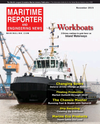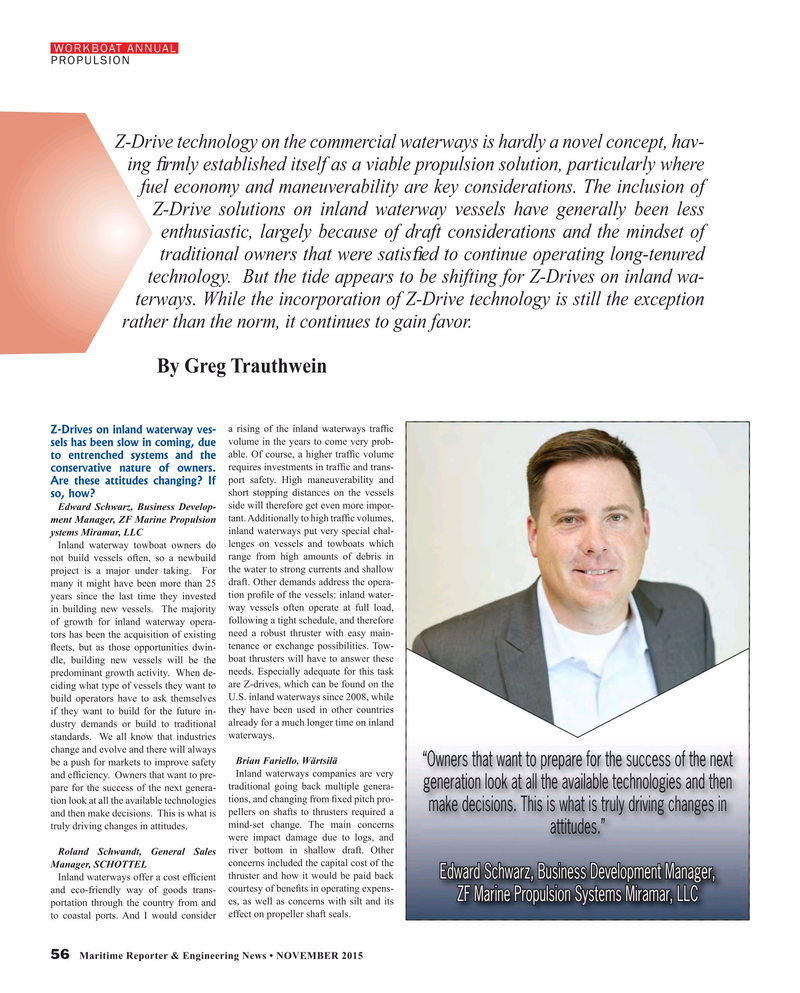
Page 56: of Maritime Reporter Magazine (November 2015)
Workboat Edition
Read this page in Pdf, Flash or Html5 edition of November 2015 Maritime Reporter Magazine
WORKBOAT ANNUAL
PROPULSION
Z-Drive technology on the commercial waterways is hardly a novel concept, hav- ing ? rmly established itself as a viable propulsion solution, particularly where fuel economy and maneuverability are key considerations. The inclusion of
Z-Drive solutions on inland waterway vessels have generally been less enthusiastic, largely because of draft considerations and the mindset of traditional owners that were satis? ed to continue operating long-tenured technology. But the tide appears to be shifting for Z-Drives on inland wa- terways. While the incorporation of Z-Drive technology is still the exception rather than the norm, it continues to gain favor. By Greg Trauthwein a rising of the inland waterways traf? c
Z-Drives on inland waterway ves- volume in the years to come very prob- sels has been slow in coming, due able. Of course, a higher traf? c volume to entrenched systems and the requires investments in traf? c and trans- conservative nature of owners. port safety. High maneuverability and
Are these attitudes changing? If short stopping distances on the vessels so, how?
side will therefore get even more impor-
Edward Schwarz, Business Develop- ment Manager, ZF Marine Propulsion tant. Additionally to high traf? c volumes, inland waterways put very special chal- ystems Miramar, LLC
Inland waterway towboat owners do lenges on vessels and towboats which not build vessels often, so a newbuild range from high amounts of debris in project is a major under taking. For the water to strong currents and shallow many it might have been more than 25 draft. Other demands address the opera- years since the last time they invested tion pro? le of the vessels: inland water- in building new vessels. The majority way vessels often operate at full load, following a tight schedule, and therefore of growth for inland waterway opera- tors has been the acquisition of existing need a robust thruster with easy main- tenance or exchange possibilities. Tow- ? eets, but as those opportunities dwin- dle, building new vessels will be the boat thrusters will have to answer these needs. Especially adequate for this task predominant growth activity. When de- ciding what type of vessels they want to are Z-drives, which can be found on the build operators have to ask themselves U.S. inland waterways since 2008, while they have been used in other countries if they want to build for the future in- dustry demands or build to traditional already for a much longer time on inland standards. We all know that industries waterways. change and evolve and there will always
Brian Fariello, Wärtsilä be a push for markets to improve safety “Owners that want to prepare for the success of the next
Inland waterways companies are very and ef? ciency. Owners that want to pre- generation look at all the available technologies and then traditional going back multiple genera- pare for the success of the next genera- tion look at all the available technologies tions, and changing from ? xed pitch pro- make decisions. This is what is truly driving changes in and then make decisions. This is what is pellers on shafts to thrusters required a mind-set change. The main concerns truly driving changes in attitudes.
attitudes.” were impact damage due to logs, and
Roland Schwandt, General Sales river bottom in shallow draft. Other concerns included the capital cost of the
Manager, SCHOTTEL
Edward Schwarz, Business Development Manager,
Inland waterways offer a cost ef? cient thruster and how it would be paid back courtesy of bene? ts in operating expens- and eco-friendly way of goods trans-
ZF Marine Propulsion Systems Miramar, LLC portation through the country from and es, as well as concerns with silt and its to coastal ports. And I would consider effect on propeller shaft seals. 56 Maritime Reporter & Engineering News • NOVEMBER 2015
MR #11 (50-57).indd 56 11/6/2015 10:50:31 AM

 55
55

 57
57
